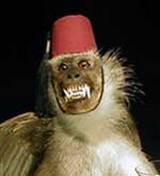
In Check and Double Check (1930) the brothers in Amos 'n Andys lodge, the Mystic Knights of the Sea wear fezzes. Janet Leigh walks into a back room where fez-adorned men are discussing charity work in Bye Bye Birdie (1963). An assassin wearing a red fez with tassle appears in Austin Powers: The Spy Who Shagged Me (1999). In Killer's Kiss, (1955) two drunken fez-wearing "conventioneers" have a short but important appearance. The fez is a common visual device in film. Heinlein, in The Cat Who Walks Through Walls, uses a semi-masonic subplot dealing with a stolen Shrine fez. Ellis Weiner's National Lampoons Doon mentions "a convention of Shriners from the Benevolent Planetary Order of Elkoids". In print, Michael Chabon's The Amazing Adventures of Kavalier Clay briefly introduces two Shriners in fezzes. When robots in Futurama (2002) party down, one wears a fez. An episode of The Ant and the Aardvark (1970) shows his fez-wearing lodge brothers. Middle-aged white conventioneers in fezzes are depicted in Mad Magazine (1998). In one episode of the online cartoon, Home Star Runner (2003) a character named Coach Z wears a crescent and star symbol and a red fez. In the comics, The Yellow Kid (1896) wore a tassled red fez. Patrick Star and Spongebob Squarepants drive a miniboat on their way to do "their civic duty". A few examples demonstrate the prevalence of the image.įrom Stan Laurel and Oliver Hardy in Sons of the Desert (1933) to The Simpsons, the image of the fez-wearing conventioneer has been used as visual shorthand and for comedic affect.

Although the members of Moose International wore a fez from their founding in 1888 until 1992, and the Benevolent Protective Order of Elks have used a purple fez with a white tassle since their founding in 1868, it is the fez-attired Shriner conventioneers of the 1920s who have entered popular history as the archetype of heavy partyers. When Daffy Duck wears a fez, he is representing indolence, not fraternalism. In popular western culture the fez continues to represent relaxation, if not debauchery.

Widely worn as military headdress, among Muslims of South Asia, the fez was a symbol of Islamic identity.

Originally of Greek origin, the fez was worn throughout the Ottoman empire in the nineteenth century by royal decree of Sultan Mahmud Khan II (1808-39). There is no evidence of truth in this story. Chick records a story that the original fez was red because it was dyed in the blood of murdered Christians. In one of his comic-strip religious tract against Freemasonry, Jack T. Chickthat the red fez commemorates the slaughter of Christians in the city of Fès are without any historical foundation. This is echoed in the opening sequence of the animated film, Hop.Īnti-masonic claimsperhaps originating with Jack T. It was not uncommon for English Victorian gentlemen of the late nineteenth century to relax at home while wearing loose smoking jackets and fez-like headdresses, an affectation often portrayed in Punch magazine illustrations of the period.

Adopted by the masonic service club, the Shriners, in the western world the fez has long been a symbol of partying conventioneers and worn by anyone attempting to imitate the playboy image of Egyptian King Farouk I (1920-1965). Formerly the national headdress of the Turks, the fez is also worn by men in Egypt and North Africa. The fez is a truncated cone-shaped felt cap, generally red, with a long black tassel. Background to end credits for The Ren and Stimpy Show, 1991-2003.


 0 kommentar(er)
0 kommentar(er)
